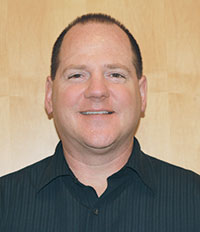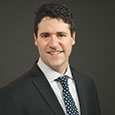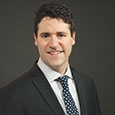When Christine Wolf became the band director of Central Davis Junior High School in 2012, there were only 55 seventh through ninth grade students in band. Today, there are more than 250 students, and they are one of the finest middle school bands in Utah. More than 40% of the diverse student body is eligible for free and reduced lunch, and there is a high mobility rate. In spite of these challenges, Wolf never doubted the potential of her students and the growth of her program.
From the moment Todd Zimbelman became the band director of West Salem High School in 2009, reaching for and achieving excellence became the culture of the band. The wind ensemble has been the Oregon concert band champion for eight years in a row, and the marching band has won the state championship six years in a row. Zimbelman’s students are constantly working on lifting the quality of individual and ensemble performance.
While there are many factors to consider in the growth and standard of excellence of these programs, one important thing they have in common is a focus on developing the right mindset. Since the publication of Carol Dweck’s Mindset: The New Psychology of Success in 2006, educators have recognized the importance that mindsets play in how we teach and how our students learn. Dweck explains that their mindsets determine how they think about their potential and ability to learn and grow. The growth mindset is defined as a belief system that suggests that one’s intelligence is malleable and can be grown or developed with persistence, effort, and a focus on learning. Those with a growth mindset look at challenges as opportunities to develop, learn, and grow, as opposed to looking at challenges as opportunities to fail. Someone who leads with a growth mindset accepts that there will be struggle, stumbling, scraped knees, and disappointment, but will continue to seek out new strategies, put in the extra time, and respond to feedback in the pursuit of growth. Henry Ford summed up the difference between a growth mindset and a fixed mindset with his famous quote, “Whether you think you can, or you think you can’t, you’re right.”
How a Mindset Develops
We are all born with a growth mindset. Imagine observing a toddler learning to walk. In those first several attempts to take a first step, the toddler repeatedly falls but gets back up and tries again and again. Eventually, the toddler learns to walk; there is no thought of giving up.
Unfortunately, as students get older, a helpless response to struggle and challenge often becomes the common response. As students enter the school system, they begin to be judged and they, in turn, judge themselves and others. While some continue to embrace learning and growth, others begin to avoid challenges for fear of failure. Many students begin to identify with certain labels, such as, “I’m smart,” “I’m talented,” “I’m not good at math,” or “I’m not good at school.” These labels emphasize the idea that students have fixed traits, abilities, and levels of intelligence. Dweck labels this concept as a fixed mindset – the belief that intelligence is something we are born with and the level of intelligence and talent cannot be changed.
Research shows that even students who have identified that they are talented or smart will often shy away from challenges that could result in failure. They believe that if they are smart or talented, they should not have to work hard. In fact, effort and work would mean to them that they must not be very smart, because as Dweck writes, “People with a fixed mindset tell us, ‘If you have to work at something, you must not be good at it.’ They add, ‘Things come easily to people who are true geniuses.’ ”
As we get older, we tend to acquire more fixed mindsets, to the point that many students and teachers have a predominantly fixed mindset. Because a fixed mindset is so common, it is important to rethink our approaches to teaching. In my career, at times, I viewed students as talented or less than talented, but what I learned through experience was that students would often perform above my initial judgment. Other students I initially judged to have a great deal of natural talent sometimes underperformed what I thought was possible. The reality is that hard work, discipline, effort, and passion can outperform innate ability, but a fixed mindset limits the desire to work hard or try new things.
How a Mindset Can Change
The good news is that we can change our mindsets and open up new possibilities. Through her years of field research, Dweck has demonstrated that when teachers and parents change their method of feedback to students, and when students learn about how the brain is malleable and adaptable and are taught about the two different mindsets, students can develop a growth mindset. In a study of fifth grade students who were given a set of puzzles to complete, one group was praised for their intelligence and the other group was praised for their effort. Those who were praised for intelligence shied away from taking on more challenging puzzles and ended up performing at a lower level than those that were praised for effort. Those who were praised for working hard were eager to take on more challenges and consequently performed at a higher level than those who were praised for an innate ability.
Teachers with a growth mindset focus on process, effort, and strategies rather than innate abilities and talent. They believe that wherever their students are when they arrive is just a starting point rather than a determining factor in how far they can go. Growth mindset teachers live by educator Haim G. Ginott’s famous quote, “Treat a child as though he already is the person he’s capable of becoming.”
Creating a Growth
Mindset Culture
A music program will have a culture; it will either happen haphazardly or by design. There are specific areas to focus on to make sure the culture develops as you desire.
Communication
The language that we use with students plays a significant role in nurturing a growth mindset. Focus on using hopeful language such as when rather than if: “I am looking forward to when we can all play the sixteenth note passage at measures 16-19.” Avoid the word can’t in rehearsals; if it is unavoidable, add yet: “We can’t play over the break yet.” The word yet is hopeful and it implies the expectation that the group will develop the skill to achieve the goal.
Judith Glaser, author of Conversational Intelligence, teaches that words affect us at a physiological level. Language that unites people by creating a sense of belonging heightens our ability to perform, achieve, and think, and even elevates the immune system. Use words like we, us, let’s, and together as often as possible to create a sense of camaraderie. People are motivated to work harder when they are in it together. In fact, in a recent study at Stanford University, when the word together was used in a work environment, productivity and effort were elevated. Using language that unites us creates trust and leads to vibrant cooperation. Conversely, avoid using I, you, or me, which can lead to division or even confrontation.
Giving Praise
Dweck’s research demonstrates that how we praise students can play a significant role in whether they develop a growth or a fixed mindset. When we praise students for being smart or talented or for learning quickly, we inadvertently teach them to avoid taking on new opportunities if these could result in failure or challenge their self-esteem. Students tend to shift to a growth mindset when we focus on the process, progress, effort, and perseverance rather than the outcome or the product. Recognize the improvements and step-by-step achievements on the path to the final performance, and avoid giving generic praise, such as “good job.” Instead, be specific, such as, “excellent improvement in maintaining pitch center through the phrase,” or “great progress in separating the staccato notes.” Challenge students to grow by letting them know what they are doing well and what needs to be improved. Zimbelman makes good use of this concept. “At the end of rehearsal, I will give such comments as ‘The first section is beautiful, but this section needs more work,’ or ‘I appreciate your time and your efforts today. This is where we need to continue to grow.’ ”
Theodore Roosevelt keenly observed, “Comparison is the thief of joy.” Avoid comparing students or ensembles, especially by using better or the best. Shawn Achor writes in his book Big Potential, “By telling someone they are ‘better’ or ‘the best,’ you are placing an unconscious, implicit limit on your expectation for what they can achieve. If we’re striving only to be better than someone else, doesn’t that set our expectations for ourselves too low? It tells us that as soon as we are just a little bit better than another person, we can stop trying, even if it means stopping short of our potential.” Maintain focus on individual improvement and progress rather than measuring a student’s work against the achievement of fellow classmates.
Giving Feedback
When giving students feedback, strive to be specific and direct, while offering solutions and strategies rather than just criticism of what is wrong. Paint the vision of what can be. For example, “The entrance was together but our release lacked clarity. Let’s release with an inhale on count 4 so that we enter silence with sensitivity.” Aim to guide students through feedback to create what success researcher Anders Ericsson in his book Peak calls a “mental representation” of how the tone quality or music should sound. Remember to use the word yet: “We haven’t achieved rhythmic clarity at measure 43 yet.” Notes Zimbelman, “Giving feedback is an excellent opportunity to remind students of the power and responsibility they have. Rather than only say something needs improvement, I say that it needs improvement in sectionals, which puts the responsibility squarely on students’ shoulders to get the work done and at the same time lets them know I believe they can accomplish the objective I just set out on their own.”
Using Body Language
We communicate an abundance of information non-verbally, especially with the eyes, smile, and torso. In fact, in a 1967 study by Albert Mehrabian it was determined that when communicating face to face, non-verbal communication conveys more (55%) about feelings and attitudes than words (7%) and tone of voice (38%) combined. Maintain an open, welcoming posture and eye contact that encourages and supports students, and respond to good progress with a smile.
Sharing Rehearsal Goals
The beginning and ending of any endeavor greatly affects the mindset, as supported by research presented by Daniel Pink in his new publication, When: The Scientific Secrets of Perfect Timing. Begin rehearsals with clear goals expressed, whether written on the board, projected on a screen, or spoken. Note what was accomplished along the way, and conclude rehearsal by reminding students what was achieved and what will need additional work at home and in the coming rehearsals. Keep the focus on the process and the journey.
Says Todd Zimbelman, “One daily goal is to focus on building technique through fundamentals. Our top group spends 30 minutes out of a 90-minute class working on technique. Our next two groups spend about 45 minutes of each 90-minute class working on technique. Students are always a reflection of their teacher. Many programs focus on technique, but if you are bored, just going through the motions of a monotonous routine, the students will pick up on that. I wrote my own technique book and like to mix it up through changing the dynamics, changing the tempo, changing the articulations. Technique building is not optional, so we make it musical and we make it passionate.”

Todd Zimbelman
Changing the Brain
Neuroplasticity is the lifelong ability of the brain to change, adapt, and rewire itself. Although it used to be thought that we were born with a set amount of intelligence or talents, we now know that we accumulate intelligence and talents throughout our entire life. Administrators have long supported the integration of science and psychology into the music classroom, but students also appreciate learning about such subjects, especially as they relate to themselves. In fact, learning through music will have a greater tendency to stick when it is connected to additional knowledge.
Rehearsals and home practice are opportunities for the brain to develop, make new connections, and rewire itself. Every time someone steps out of a comfort zone to learn new skills and information, new connections are formed in the brain. The reason people might struggle with new challenges is that such connections start out weak. It is only with persistent, deliberate practice that the unfamiliar becomes the familiar.
Daniel Coyle in The Talent Code shares new research on how the growth of myelin in the brain signifies the development of skills and habits. When we first try a skill, the brain creates a wrap of myelin around an axon or neuron. Continued practice leads the brain to wrap more myelin around the axon. Myelin acts as a superconductor for information to travel faster in the brain. Someone who has a technical skill, such as a full-range chromatic scale, has merely put in more time to grow more myelin. Because the brain is malleable and changeable, we can develop skills through effort. Aristotle wisely noted, “We are what we repeatedly do. Excellence, then, is not an act, but a habit.” Christine Wolf notes, “We have a poster in the room that says, ‘Hard work beats talent when talent doesn’t work hard.’ I keep the focus on hard work and effort. If a student says something is difficult, we respond, ‘It’s not difficult, it’s just unfamiliar. When it becomes familiar, then it becomes easy.’ ”
Although repetition is the key to success, this does not apply to mindless repetition. Instead of just telling students to practice at home, teach and demonstrate practicing skills so that students have the knowledge to develop their skills effectively. To succeed, students need to know what to practice and how to approach it best, along with consistent and specific feedback. Zimbelman states, “I refer to The Brain that Changes Itself by Norman Doidge quite a bit. We talk about being consistent with how you practice and perform and how to raise the percentages – how to raise your odds of getting it right.”
Walk students through the problem-solving steps to figuring out a rhythmic challenge or a difficult interval. Modeling is one of the most important forms of leadership. This can be applied not only to practice but also to other skills, such as running a sectional or taking a student leader position. Students can also do this for each other. Establish a mentoring or tutoring system for experienced students to guide younger ensemble members. Have students compare learning strategies, because often the missing link in one player’s success is a strategy that another student found. Wolf says, “At first, I ran the sectionals, but now the students know the process and expectations, and I need only check in with them. Students know how to lead warmups, chorales, and tuning, as well as how to fix notes and rhythms. We also have student teacher assistants in the different bands, so an eighth grade student leader, for example, mentors and tutors seventh grade band students.”
The aim is to view challenges as opportunities for growth. Openly display your curiosity and love of challenges by sharing what you are reading and listening to. Let students know about conferences and clinics you attended and what you learned. Says Zimbelman, “It is important to me build a strong work ethic in my band program. I never feel like I have arrived. I always feel like there is more to learn and more to grow, so I keep working on myself, too.” Acknowledge that everyone is a lifelong learner and might not immediately have the answer to every question, but when you do not know an answer, look it up – or better yet, ask students to research the question and report back the next day.

Christine Wolf
Expectations
Set high standards and expectations, and do not be afraid to raise the bar as students progress. Zimbelman observes, “The expectation and belief of the teacher has much to do with what students can achieve. Students will do what you expect them to do. I expect them to play like college and semi-professional players. I expect their parts are learned before rehearsal. I expect them to seek out knowledge of their instruments on their own. Our culture is one of drive and a relentless pursuit of excellence.”
As long as students are equipped with the right strategies, tools and guidance, they will succeed. When remembering the first year at her current position, Wolf says, “There was nowhere to go but up. We were near the bottom of both the district and state in numbers and proficiency. I looked at the remaining students and figured that if they were still here when everyone else bailed, they must really want to learn music. You have to teach the students where they are at. Everything was learned by rote before I arrived, so I had students play grade 1 literature for that first year so that they could work on sounding good. I had discussions with the students about trusting me and my process – trusting that if they did as I asked, they would improve and sound good. When students sound good, they will want to work harder. You have to find ways for the students to learn what it is to sound good and succeed.
“I came in with strict expectations on what and how we practiced. In addition to turning in detailed practice records, students are assessed in a variety of ways through performance evaluations, written assessments, and SmartMusic. Students also assess their own performance and participation regularly. I’m a mom with four kids. In the balance of home and work, I do not have endless amounts of time to stay at the school. I cannot do it all for them. The students have to be taught how to be self-sufficient, disciplined, and accountable. The job of rehearsal is to learn how your part fits in with everybody else’s part, and that only happens if students come to rehearsal ready to do so. They should also be able to figure out how to finger a note from the fingering chart and should ask a neighbor before asking me. Give students the tools and they will be successful.”
A Safe Environment
Create an environment where it is safe to take risks, to stumble, and try again. How we respond to our failures and struggles influences how our students will respond to theirs. It will help your students if you share stories of musical or technical struggles that you overcame, as sharing stories of struggle and perseverance opens pathways for connection and trust. One of my greatest challenges in junior high was learning to tap my foot to the beat of the metronome rather than the rhythm of the music. I wrote in the counting and drew down and up arrows on every beat to show what my foot should be doing. I practiced slowly and sang my music while tapping my foot. After untold hours of practice, I was finally able to tap my foot to the beat while playing complex syncopated rhythms, but it was hard work. It did not come naturally. Challenge students to wrestle with their mindset by having them write about something they were unable to do or understand, and what it took to learn what they now know.
Says Wolf, “Every student can retake every playing assessment. I want to see improvement and to know that they get it at some point. When the clarinets are learning to play over the break for the first time, many of them struggle. I encourage students not to give up, which is especially important once some students can cross the break successfully while others are still working at it. I give students exercises and tools to make it happen, and I promise that if they keep practicing these exercises, they will be able to play over the break too.
“I take into account that some students will need accommodations. I work with them so that they can be successful on what I ask them to play, and I look at their effort. If they practice consistently and attend all the sectionals, talent is irrelevant. If students give me their best effort, I will not fail them.”
Student Input
Students who are empowered to make decisions, permitted some autonomy, and given a voice in the learning process will be more engaged and likely to embrace a growth mindset. When students are involved in the creation of goals for the music program, they are more motivated to accomplish them. In addition to asking students for input and feedback on the ensemble’s goals, ask them to create a plan with benchmarks and strategies to achieve the goals. Share the responsibility of evaluating rehearsals and performances with students; this gets them engaged in their development as musicians. Create a sense of autonomy for students by giving them time in rehearsal to discuss in sections what they can improve. Every student in the section can offer input. Give students the opportunity to step out, listen, and offer support and advice to their peers. Wolf notes, “During rehearsal, I encourage students to share their thoughts. It is quite common for a student to raise a hand and suggest that we work to improve the balance, phrasing, or intonation of a section of the music. I also ask students to share ideas on imagery, stories in the music, and the emotion that a crescendo or section of the piece conveys. At the end of a rehearsal of a piece, I will often ask students to write in at least three things that they know they need to fix. This teaches them to take responsibility and to be effective listeners. Teaching students how to assess themselves makes their individual practice more effective.”
Rather than obsessing over winning championships or festivals, growth mindset goals should focus on improving as performers and people. Zimbelman balances this well. “We do not focus on competition. We do not go out to win things. We never talk about talent. We always try to make the music sound great and be true to the composers’ intentions to the point that they would be thrilled with how we perform their music if they walked into the room. The standard is always a high level of performance: together and in tune, clear and balanced.
“Within the band, however, we embrace competition. We have chair challenges regularly but they are done in a healthy way. The two students perform in the room next door with the door open so that we cannot see who is playing. The music is projected onto the screen, and the students vote on the challenge. The students always applaud for the effort. If you get beat, you congratulate the other person. There are no tears. There is no drama. If you want that spot back, then re-challenge the next week.”
Conclusion
Music educators like Todd Zimbelman and Christine Wolf exemplify what is possible when we create growth mindset music programs. A growth-minded learner recognizes that learning is a process that takes time, effort, discovery and implementation of appropriate practice strategies, and specific feedback. When we recognize the unlimited potential of our students, the journey of teaching music becomes even more meaningful and exciting. We discover that rather than natural talent leading to success, it is through effort, time, the application of effective learning strategies, and practice that our students grow and develop. In the end, it is all about the journey and the joy of making music.
***
References
Believe in Students by Matthew Arau (YouTube).
Big Potential by Shawn Achor (Currency) .
Bounce: Mozart, Federer, Picasso, Beckham, and the Science of Success by Matthew Syed (Harper
Collins).
Broadcasting Happiness by Michelle Gielan (BenBella Books).
Conversational Intelligence: How Great Leaders Build Trust and Get Extraordinary Results by Judith E. Glaser (Bibliomotion).
The Culture Code by Daniel Coyle (Bantam Books).
Mindset: The New Psychology of Success by Carol S. Dweck (Random House).
Peak: Secrets from the New Science of Expertise by Anders Ericsson and Robert Pool (Houghton Mifflin Harcourt).
The Power of Yet (TED Talk by Carol Dweck).
The Talent Code by Daniel Coyle (Bantam Dell).
Talent is Overrated by Geoff Colvin (Penguin).
Unlocking Potential: The Impact of Mindset on Success by Matthew Arau (www.musicianstoolkit.com).
When: The Scientific Secrets of Perfect Timing by Daniel H. Pink (Riverhead Books).






